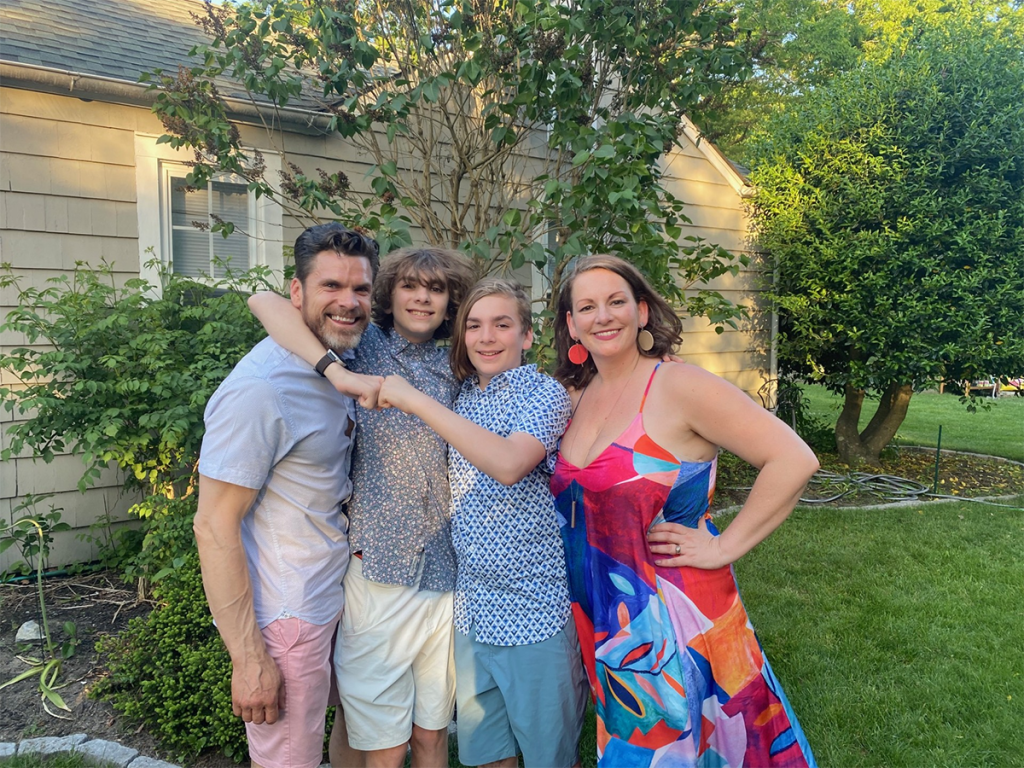
A woman walks in with her sketchbooks, fabric samples, photos, a few iconic costumes, and reams of official forms. “What most people don’t know about costume designing is the amount of organizational paperwork required for the entire production,” opines Amanda Downing Carney, Costume Director since 2015 for Trinity Repertory Company in downtown Providence. “Measurement sheets, sourcing lists, charts, design renderings, research, costume plots, checklists, alteration notes, running sheets and lists of pieces, accessories, dressing, and fix-it projects,” she enumerates in recognition of the complex art and creative science of costume design. Carney is at the Warwick Center for the Arts addressing an audience of sewing compatriots, the RI Sewing Network, to unravel the secrets, magic, and framework of costume design.
Costume design is a visual art form allowing for non-verbal storytelling. Costumes shape the audience’s perceptions of characters, story, time period and stage setting. Costume designers are part artisan, organizer, magician, diviner, and seer – they maneuver around the stage. It is vital to communicate the theme immediately to the audience. Carney recounts, “my job is to enable the director’s vision.” Carney explains costumes provide context and clues to shape the audience’s perception of time, place, social status, and gender, with an impact and immediacy words cannot.
Costumes provide context to the audience, shaping their understanding of the place, time period, and social standing. Each costume build takes about 3-6 weeks. They must allow for movement and be able to be put on/ removed quickly for costume changes on cue. Costume designers take part in an incredibly cohesive and collaborative process with the set designer. How will the costumes impact, clash, blend in, or enhance the set design and props? Prep work is essential. After a complete reading of the script, Carney meets with the director to assess the intended vision. What is the story the director is trying to tell? Before she dives into the script and character analysis, she asks, “Why this story? Why now? Who is it for?” Carney says, “I approach my work first as an artist.” She affectionately calls her process, Brain to Stage. “Once I read the script, I see the entire play, images in my head, like a movie,” she confesses. The show must work both artistically and practically, so the first step is to create a costume plot. “Transitions and costume changes can kill a production,” she warns.
Every production is a collaborative experience, interacting with and critiquing various personalities, opinions, and ideas. It takes a team to build a theatrical wardrobe. From stitchers, seamstresses and drapers to builders, painters, wigmakers and milliners, Carney’s team manages all aspects of dressing the actors. They source materials, fabrics, and even ‘rescue’ vintage fashion finds from Savers. They keep tabs on a huge warehouse of costumes (re-use, re-work, lend out). “Acting is not stationary,” she emphasizes, “Details are essential for visual impact, form, and function of dressing for every show.” Consideration is given to required costume changes, space on the stage, freedom of movement, weight, and sometimes weather (when it’s an outdoor production). Colors evoke feelings, emotions, and often provide implicit meaning and even project multisensory reactions. “Red is a color I use sparingly.” For Trinity’s recent smash, “the first – most important – piece of our costume build was the shoes, we needed heels to fit the male cast,” muses Carney, “It’s not an easy feat to find shoes that are perfectly comfortable for moving around the stage and dancing.” It was essential for the actors to break in the dancing slippers weeks prior to rehearsals.
Throughout her career, Carney has learned how to persevere, saying “When I hit a wall or an idea gets rejected, I try not to sweat it because whatever I do next, usually is better.” One of Carney’s favorite projects was Trinity’s 2023 The Inferior Sex, based on congresswoman and political trailblazer, Shirley Chisholm, who famously wielded fashion to grab the spotlight in her run for the presidency and battle for ERA. As part of the all-female crew and slate of actors, Carney dabbled in vibrant colors and patterns with a feminine flair to recreate Chisholm’s iconic outfits of the 1970s. “This was history, so it was essential to get the wardrobe right,” she explains, “we even had a fabric pattern created.”
A native Rhode Islander and self-professed ‘Swamp Yankee,’ Carney credits her maternal grandmother as her muse. Diligent, energetic, and clever, her grandmother raised seven children before going to college to earn a degree in Home Economics. She was legendary for gifting lovedones with her hand-made purple Tulip quilts and helped Carney craft her first quilt by age ten. Carney has worked professionally in the arts for almost twenty years. She has designed and managed wardrobes for national and international tours as well as various theaters (The Gamm Theater, The Contemporary Theatre, Wilbury Theatre Group, and Nantucket’s White Heron Theatre). Earning her BFA in technical theater/ costume design at URI, Carney studied under artist, costume designer and professor, David T Howard. At Trinity, she was promoted to Costume Director in 2015. Her work includes La Broa’, The Inferior Sex, Tiny Beautiful Things, Fade, and An Iliad. •
RI Sewing Network (rhodeislandsewingnetwork. com) is a non-profit organization for professional and non-professional sewing enthusiasts throughout Southern New England with strong ties to URI.
Amanda with her husband of 17 years, Joe Carney, and sons, Leander, 13yrs, and Tristan, 12yrs. (Photos courtesy of Amanda Downing Carney)
